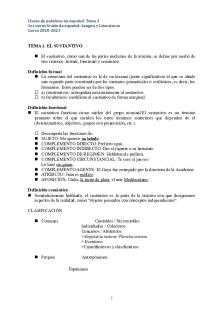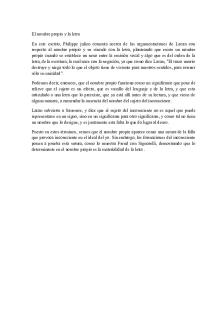El nombre - Spanish Grammar Point PDF

| Title | El nombre - Spanish Grammar Point |
|---|---|
| Course | French and Spanish |
| Institution | Cardiff University |
| Pages | 4 |
| File Size | 96 KB |
| File Type | |
| Total Downloads | 78 |
| Total Views | 129 |
Summary
Spanish Grammar Point...
Description
Nouns 4 Different Types: -
Abstract (Faith) Tangible (A Car) Common ( Month) Proper (Spain)
● Can be a direct or indirect object of a sentence D.O = Mary is ill I.O. = I love my dogs
Feminine Nouns: -
Ending in -dad, -tad, -tud, -umbre, -ción, -sión.
e.g. La ciudad, La actitud
● All nouns ending in a consonant form the plural by adding “-es” ● Nouns ending in a vowel generally add an “-s” to form the plural e.g. las ciudades, las actitudes *Note that nouns ending in “-ción” and “-sión” drop the written accent in the plural.
● Some nouns don’t change in the plural: Words ending in an unstressed vowel plus “s”. -
El / Los Atlas El / Los Cactus La / Las Thesis El / Los Virus
● Some feminine nouns that begin with a stressed “-a” take the masculine definite article when the first syllable is stressed.
e.g.
So the two vowels aren't too difficult to pronounce. The words are always considered feminine El aguila goes to Las Aguilas El Hacha goes to Las Hachas El Arma goes to Las Armas
● Some masculine nouns end in “-a” -
El mapa El drama El sistema
● Nouns ending in “-ista” refer to professions or political persuasions. They take the masculine article when referring to men and the feminine for women. -
El Dentista El Novelista
- La Dentista - La Novelista
● Nouns ending in “-e” can be masculine or feminine but are more likely ot be masculine -
El parque El coche
- El cafe - El bosque
*Note that El Arte becomes feminine in the plural e.g. Me encantan las bellas artes. -
La calle La leche
- La clase - La gente
● Nouns ending in “-ente” usually refers to people and can be both genders - However many spanish people will change “-nte” to “-nta” if talking about a women.
e.g. -
El presidente El pariente
- La Presidente - La Pariente
- La presidenta - La parienta
*For estudiante and cantante, it is far more common to stick to the normal ending and not add an “-a”
● Nouns ending in “-í , -ú or á” - In the plural to be formal add “-es”, but to be informal solely add “-s” - Both are correct e.g. - El hindú - El tabú
- Los hindúes / hindús - Los tabúes / tabús
Irregularities: -
La mano : ends in “o” but is feminine La foto : short for fotografia and so is feminine La moto: short for motocicleta and so is feminine
There are many Spanish nouns which change gender according to its gender: -
El Cura (Priest) El Capital (investment) El Corte (cut)
- La Cura (Cure) - La Capital (city) - La Corte (court)
Compound Nouns : combination of verbs adjectives or a preposition with a noun to form one word - They’re usually masculine, and although they look plural are actually singular. - Change the article to get the plural (El to Los) e.g. - El/Los Abrelatas - El/Los Compleaños - El/Los Paraguas - El/Los Guardaespaldas
Diminutives and Augmentatives
e.g.
“-ito” and “-illo” can be added to the noun to form the diminutive form Refers to the physical size of the noun Can show emotional quality on the part of the speaker - Casita (little house) - Chiquita (Cute little girl)
- Perrito (cute little dog) - Vasito (little glass)
● Diminutive endings vary among the spanish speaking world “-ito” and “-illo” are the most common - Among cuban speakers “-ico” is also common ● e.g.
If the noun ends in “-r” , “-n” or “-e” the affix “-cito” is generally added. - El cafecito
- El cochecito
● Augmentative forms are used less commonly *Better not to use them until you are quite fluent in Spanish....
Similar Free PDFs

Tema 2. El nombre común
- 8 Pages

El nombre de la rosa
- 10 Pages

El nombre de la rosa personajes
- 1 Pages

Spanish
- 5 Pages

Resumen El nombre de la rosa
- 4 Pages

El nombre propio y la letra
- 1 Pages

El Nombre de la Rosa (Ensayo)
- 4 Pages
Popular Institutions
- Tinajero National High School - Annex
- Politeknik Caltex Riau
- Yokohama City University
- SGT University
- University of Al-Qadisiyah
- Divine Word College of Vigan
- Techniek College Rotterdam
- Universidade de Santiago
- Universiti Teknologi MARA Cawangan Johor Kampus Pasir Gudang
- Poltekkes Kemenkes Yogyakarta
- Baguio City National High School
- Colegio san marcos
- preparatoria uno
- Centro de Bachillerato Tecnológico Industrial y de Servicios No. 107
- Dalian Maritime University
- Quang Trung Secondary School
- Colegio Tecnológico en Informática
- Corporación Regional de Educación Superior
- Grupo CEDVA
- Dar Al Uloom University
- Centro de Estudios Preuniversitarios de la Universidad Nacional de Ingeniería
- 上智大学
- Aakash International School, Nuna Majara
- San Felipe Neri Catholic School
- Kang Chiao International School - New Taipei City
- Misamis Occidental National High School
- Institución Educativa Escuela Normal Juan Ladrilleros
- Kolehiyo ng Pantukan
- Batanes State College
- Instituto Continental
- Sekolah Menengah Kejuruan Kesehatan Kaltara (Tarakan)
- Colegio de La Inmaculada Concepcion - Cebu








